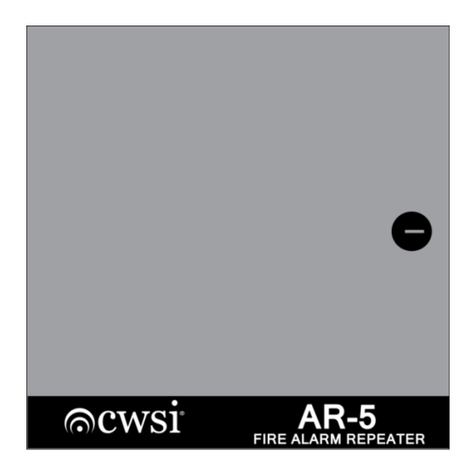When the detector senses smoke the Red LED turns on steady, the internal sounder* turns
on in the temporal 3 pattern and the following occurs:
1. An initial alarm signal is transmitted.
2. A 60 second delay occurs. If smoke clears the detector during this delay the alarm
condition is reset and a restore signal is sent ending the alarm cycle.
3. The continued alarm condition causes a repeat alarm transmission.
4. Another 60 second delay as in step 2 occurs.
5. Step 4 repeats at 60 second intervals until the detectors alarm condition is cleared.
*If the detector is configured as sounder on.
CO Alarm Operation:
When the detector senses CO toxic gas which exceeds minimum alarm levels, the Red LED
blinks, the internal sounder* turns on in the temporal 4 pattern and the following occurs:
1. An initial alarm signal is transmitted.
2. A 60 second delay occurs. If CO gas clears the detector during this delay the alarm
condition is reset and a restore signal is sent ending the alarm cycle.
3. The continued alarm condition causes a repeat alarm transmission.
4. Another 60 second delay as in step 2 occurs.
5. Step 4 repeats at 60 second intervals until the detectors alarm condition is cleared.
*If the detector is configured as sounder on. Temporal 4 will sound continuous for 4 minutes
then change to once every 60 seconds.
Heat Alarm Operation:
When the heat thermistor senses temperature in excess of 135 F, the internal sounder* turns
on in the temporal 3 pattern and the following occurs:
1. An initial alarm signal is transmitted.
2. A 60 second delay occurs. If the temperature at the heat sensing thermistor falls under
135 F during this delay, the alarm condition is reset and a restore signal is sent ending the
alarm cycle.
3. The continued alarm condition causes a repeat alarm transmission.
4. Another 60 second delay as in step 2 occurs.
5. Step 4 repeats at 60 second intervals until the detectors alarm condition is cleared.
*If the detector is configured as sounder on.
Tandem Sounder Feature
The detector canbe installed in both living andcommon areas.When it is installed in common
areas do not program the tandem feature. The model 360/370 allows the detectors piezo
sounder to be turned on or off in tandem with an RF command signal from the FACP. This
enables an installation to be programmed so that when an alarm is received from any
detector in alarm the FACP can activate the sounder in one or more detectors that are not in
alarm. When activated, the sounder will turn on in either temporal 3 or temporal 4 patterns
depending on what detector type generated the alarm. Note: Only the detector in alarm
will transmit an alarm signal. This detector must be configured for tandem on and the
feature must be programmed into the FACP to function. Refer to the FACP manual for
additional information and programming instruction. If the detector is in alarm due to local
detection the tandem silence signal or reset from the control panel will not silence the
sounder. If the detector is in alarm due to local detection and it receives the tandem on signal
the sounder will remain active even if the detector clears locally. A tandem silence signal or
FACP reset will be required to turn off the sounder.
Detector Testing
Detectors must be tested after installation and following maintenance or battery replacement.
NOTE: Before testing, notify the proper authorities that maintenance is being
performed and the system will be temporarily out of service. Place the FACP in test to
prevent any unwanted alarms. Perform all of the applicable tests below based on the





























